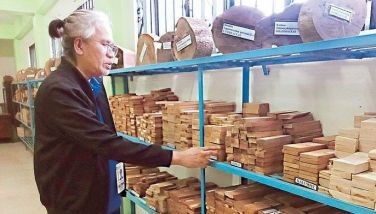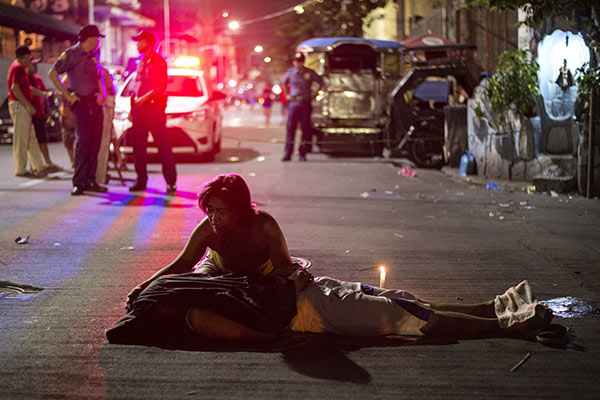PAGASA: There’s no heat wave
April 11, 2001 | 12:00am
Keep your cool, there is no heat wave.
The Philippine Atmospheric, Geophysical and Astronomical Services Administration (PAGASA) denied yesterday reports that it had declared there was a heat wave in some parts of the country, particularly in Luzon and the Visayas.
According to meteorologist Nataniel Cruz of the Climatology and Agro-Meteorology Department, the current high temperature is normal.
"There is no heat wave right now because the degree of the hot temperature that the country is presently experiencing is but a normal occurrence for the year," Cruz said.
He said the Philippine dry season runs from February through May, peaking in the month of April. In the past days, the temperature in Manila has reached a searing 35 degrees Celsius, which PAGASA said was still three degrees shy of the record 38 degrees Celsius recorded three years ago.
Cruz said a heat wave could only be declared in a tropical country like the Philippines if temperature reaches the 38 to 39 degree Celsius level, which he said is not likely to hit soon.
PAGASA said that what the country is experiencing is the "Type 2 weather" which occurs between the end of the northern monsoon and the beginning of the southwest monsoon season.
"Type 2 weather" usually triggers two months of dry spell, PAGASA added.
Cruz likewise clarified that the present hot climate has nothing to do with the impending El Niño phenomenon which is set to strike the country in October or before yearend.
PAGASA said that a heat wave, like one experienced in the United States, is "an abnormally and uncomfortably hot and humid condition" that lasts for two or three days, with temperatures breaching 41 degrees Celsius.
Nevertheless, he said PAGASA echoes the public advisory issued by the Department of Health (DOH) to avoid being under the sun for too long to prevent heatstroke, and to drink extra iced water or fruit juices to avert dehydration due to excessive sweating.
"Prolonged sun exposure and the failure to replenish one’s lost body fluids is always detrimental to one’s health whether there is a heat wave or not. Thus, it pays if one makes it a habit to drink even just water to prevent heat stroke and heat exhaustion," Cruz added.
The intense heat of the past days prompted the DOH to advise the public, especially mothers, to take necessary precautions as heat stroke and heat exhaustion are common during hot temperatures.
Health Secretary Manuel Dayrit explained that heat stroke is an illness caused by prolonged exposure to high temperatures.
Its symptoms include sudden dizziness, weakness, feeling faint, headache, high body temperature of 38.9 degrees Celsius without sweating, rapid heartbeat, muscle cramps and dark yellow or orange urine.
On the other hand, heat exhaustion is loss of body fluids from sweating and failing to drink enough replacement fluids.
Its risk factors include sweating and inadequate fluid intake, recent illness involving fluid loss from vomiting or diarrhea, and exercising or working in a hot environment.
Both heat stroke and heat exhaustion require the medical attention of a physician.
"The best remedy to hot weather is to stay indoors if possible and to drink plenty of cold water or fruit juices to fight heat stroke and heat exhaustion," Dayrit said.
He identified those working in construction, roofing, road maintenance, steel mills, underground mining, smelting and foundry operations, bakeries and restaurants as most exposed to hot environmental conditions and so are at greater risk.
To prevent further the onset of the two conditions, the health chief advised the public to wear loose-fitting clothes, preferably cotton shirts. He also said an improved ventilation while indoors will make it easier for sweat to evaporate.
Fans, air-conditioners, and foods rich in potassium such as orange juice and bananas will also go a long way to help keep one’s cool in the long hot summer, he said. –With Felix de los Santos
The Philippine Atmospheric, Geophysical and Astronomical Services Administration (PAGASA) denied yesterday reports that it had declared there was a heat wave in some parts of the country, particularly in Luzon and the Visayas.
According to meteorologist Nataniel Cruz of the Climatology and Agro-Meteorology Department, the current high temperature is normal.
"There is no heat wave right now because the degree of the hot temperature that the country is presently experiencing is but a normal occurrence for the year," Cruz said.
He said the Philippine dry season runs from February through May, peaking in the month of April. In the past days, the temperature in Manila has reached a searing 35 degrees Celsius, which PAGASA said was still three degrees shy of the record 38 degrees Celsius recorded three years ago.
Cruz said a heat wave could only be declared in a tropical country like the Philippines if temperature reaches the 38 to 39 degree Celsius level, which he said is not likely to hit soon.
PAGASA said that what the country is experiencing is the "Type 2 weather" which occurs between the end of the northern monsoon and the beginning of the southwest monsoon season.
"Type 2 weather" usually triggers two months of dry spell, PAGASA added.
Cruz likewise clarified that the present hot climate has nothing to do with the impending El Niño phenomenon which is set to strike the country in October or before yearend.
PAGASA said that a heat wave, like one experienced in the United States, is "an abnormally and uncomfortably hot and humid condition" that lasts for two or three days, with temperatures breaching 41 degrees Celsius.
Nevertheless, he said PAGASA echoes the public advisory issued by the Department of Health (DOH) to avoid being under the sun for too long to prevent heatstroke, and to drink extra iced water or fruit juices to avert dehydration due to excessive sweating.
"Prolonged sun exposure and the failure to replenish one’s lost body fluids is always detrimental to one’s health whether there is a heat wave or not. Thus, it pays if one makes it a habit to drink even just water to prevent heat stroke and heat exhaustion," Cruz added.
The intense heat of the past days prompted the DOH to advise the public, especially mothers, to take necessary precautions as heat stroke and heat exhaustion are common during hot temperatures.
Health Secretary Manuel Dayrit explained that heat stroke is an illness caused by prolonged exposure to high temperatures.
Its symptoms include sudden dizziness, weakness, feeling faint, headache, high body temperature of 38.9 degrees Celsius without sweating, rapid heartbeat, muscle cramps and dark yellow or orange urine.
On the other hand, heat exhaustion is loss of body fluids from sweating and failing to drink enough replacement fluids.
Its risk factors include sweating and inadequate fluid intake, recent illness involving fluid loss from vomiting or diarrhea, and exercising or working in a hot environment.
Both heat stroke and heat exhaustion require the medical attention of a physician.
"The best remedy to hot weather is to stay indoors if possible and to drink plenty of cold water or fruit juices to fight heat stroke and heat exhaustion," Dayrit said.
He identified those working in construction, roofing, road maintenance, steel mills, underground mining, smelting and foundry operations, bakeries and restaurants as most exposed to hot environmental conditions and so are at greater risk.
To prevent further the onset of the two conditions, the health chief advised the public to wear loose-fitting clothes, preferably cotton shirts. He also said an improved ventilation while indoors will make it easier for sweat to evaporate.
Fans, air-conditioners, and foods rich in potassium such as orange juice and bananas will also go a long way to help keep one’s cool in the long hot summer, he said. –With Felix de los Santos
BrandSpace Articles
<
>
- Latest
- Trending
Trending
Latest
Trending
Latest
Recommended





























